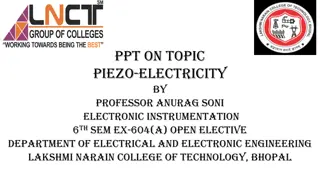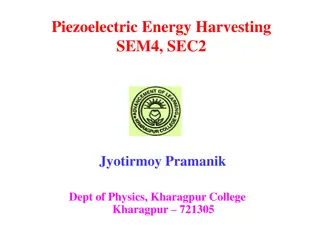PIEZOELECTRICITY
Piezoelectricity is an intriguing phenomenon where certain materials generate an electric charge in response to mechanical stress. This interaction between mechanical and electrical properties has found applications in various fields, from sensors in consumer electronics to actuators in medical devices. Understanding the principles of piezoelectricity is crucial for developing innovative technologies that harness this unique property. Dive into the world of piezoelectricity and discover its significance in modern science and engineering.
Download Presentation

Please find below an Image/Link to download the presentation.
The content on the website is provided AS IS for your information and personal use only. It may not be sold, licensed, or shared on other websites without obtaining consent from the author.If you encounter any issues during the download, it is possible that the publisher has removed the file from their server.
You are allowed to download the files provided on this website for personal or commercial use, subject to the condition that they are used lawfully. All files are the property of their respective owners.
The content on the website is provided AS IS for your information and personal use only. It may not be sold, licensed, or shared on other websites without obtaining consent from the author.
E N D
Presentation Transcript
PIEZOELECTRICITY PIEZOELECTRICITY
WHAT IS PIEZOELECTRICITY? Piezoelectric materials are produce an electric voltage when deformed mechanically such as by squeezing or tapping. The reverse effect is also true. If we apply a voltage to the material, it deforms. One early application of piezoelectric materials was for sonar in WWI. Other applications include: sensors, actuators, artificial muscles, light-up shoes, and many more.
PIEZOELECTRICS AND ENERGY HARVESTING Imagine charging your phone as you walk, thanks to a paper-thin generator embedded in the sole of your shoe. One of the most exciting advancements in the field of materials science is using piezoelectric materials to harvest energy from everyday occurrences, like walking, climbing stairs, opening and closing doors any sort of movement. This can be done by placing piezoelectric materials where they experience a great number of mechanical deformations. Then, the electric potential created is stored in batteries for later use.
ENERGY HARVESTING APPLICATIONS Piezoelectric Sidewalks and Highways In France, piezo sidewalks power a town s street lights as people walk over the piezo elements and deform them. In Israel, the same principle has been scaled up to a stretch of highway that converts the energy from cars driving over the piezo elements in the road to collect power for a nearby small town.
ENERGY HARVESTING APPLICATIONS Piezo-Clothing Georgia Tech researchers created tiny flexible piezoelectric generators that can be embedded in fabric. As you move throughout the day, clothes made with this fabric could generate enough power for small electronic devices such as calculators and phones. Piezo-Cars A Jaguar concept car has a thin coating of piezoelectric materials on the outside of the body. When the car moves down a road, the air moving past it deforms the piezoelectric materials, generating electricity to recharge the car battery. This design has the potential to develop into electric cars with unlimited range!
WHY ARE ONLY SOME MATERIALS PIEZOELECTRIC? To answer this question, let s look at the materials on the atomic level. The crystal structure of a material how the atoms and charges are arranged determine if it is piezoelectric. First, lets look at non-piezoelectric materials: These materials have symmetric atomic structures. If we flip them in any direction, the positive and negative charges are in the same locations. If we average the locations of the positive and negative charges, to find what are called the centers of charge, we notice that these locations overlap. This overlapping causes the charges to cancel out and no electricity is generated. When we deform the material by stretching it, the positive and negative centers of charge do not change, and still no electricity is generated. Thus, the material is non-piezoelectric.
WHY ARE ONLY SOME MATERIALS PIEZOELECTRIC? If symmetric materials are non-piezoelectric, that means that non-symmetric materials are piezoelectric. Lets look at the structure of a piezoelectric material: At first glance, the structure appears to be symmetric. If we flip it around, the shape may look the same, but the positions of the positive and negative charges may change. Thus, it is not symmetric. Again, when we find the centers of charge for this material, they overlap and no electricity is generated. However, when we deform the material by stretching it, the positive and negative centers of charge no longer overlap. Since these centers of charge do not overlap and cancel each other out, some electricity is generated! This material is piezoelectric.
IS ENERGY REALLY CREATED? While devices using piezoelectric materials are called generators, no energy is actually created! In fact nowhere in the entire universe is energy ever created! This is one of the fundamental laws of physics. If this is true, then from where is this electricity or energy coming? Even though energy cannot be created, it can be converted from one type to another. In the case of piezoelectric materials, mechanical energy, from applying some force to deform the material, is converted into electrical energy. The reverse effect enables piezoelectric materials to convert electrical energy back into mechanical energy, making them very useful materials.
QUESTIONS? QUESTIONS?





